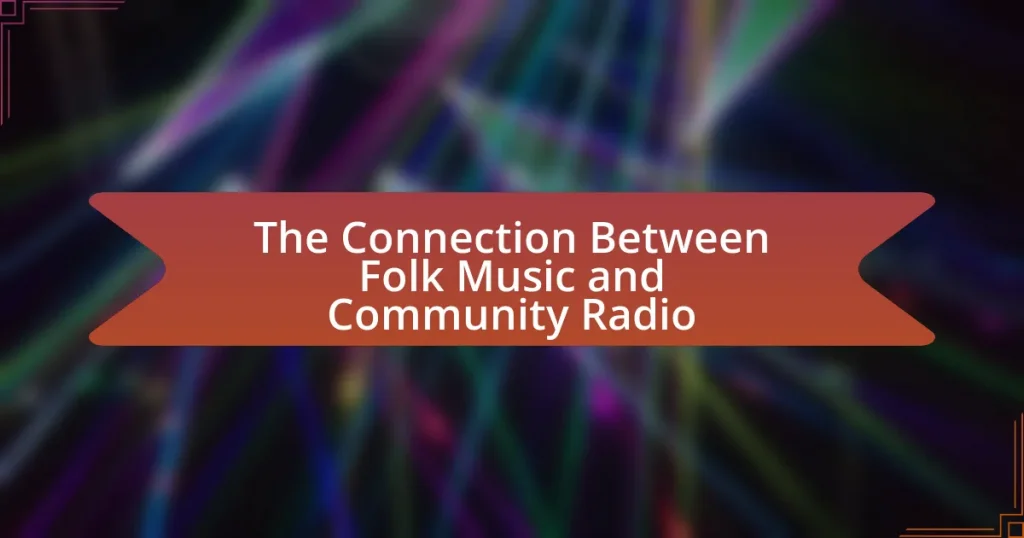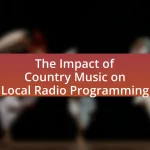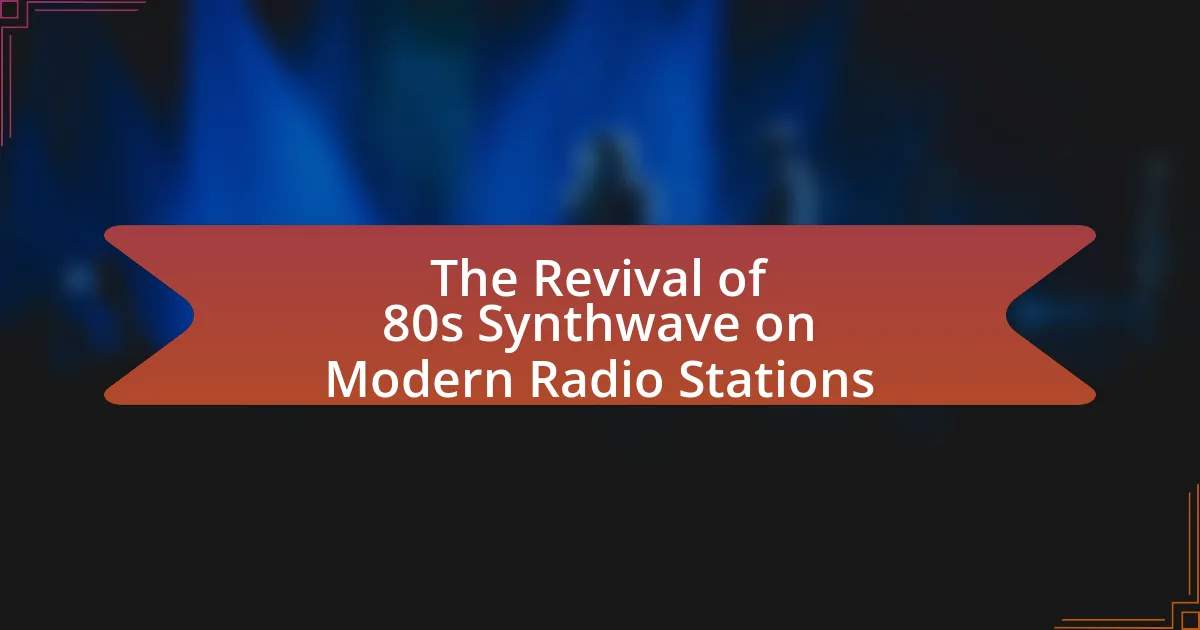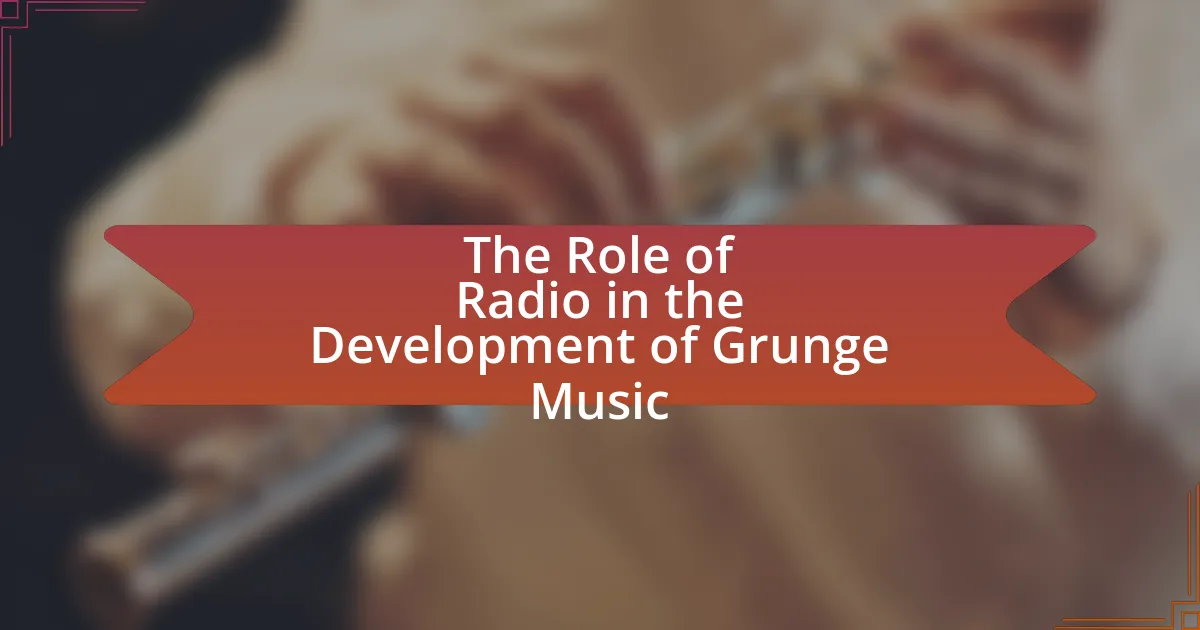The article explores the connection between folk music and community radio, highlighting their shared focus on local culture and grassroots participation. It details how community radio stations prioritize folk music to reflect and promote cultural heritage, providing platforms for local artists and traditional sounds. The article discusses the role of folk music in fostering community identity, enhancing engagement, and preserving musical traditions, while also addressing the challenges faced by community radio in promoting folk music amidst competition from mainstream media. Additionally, it outlines best practices for community radio stations to effectively support and promote folk music initiatives.
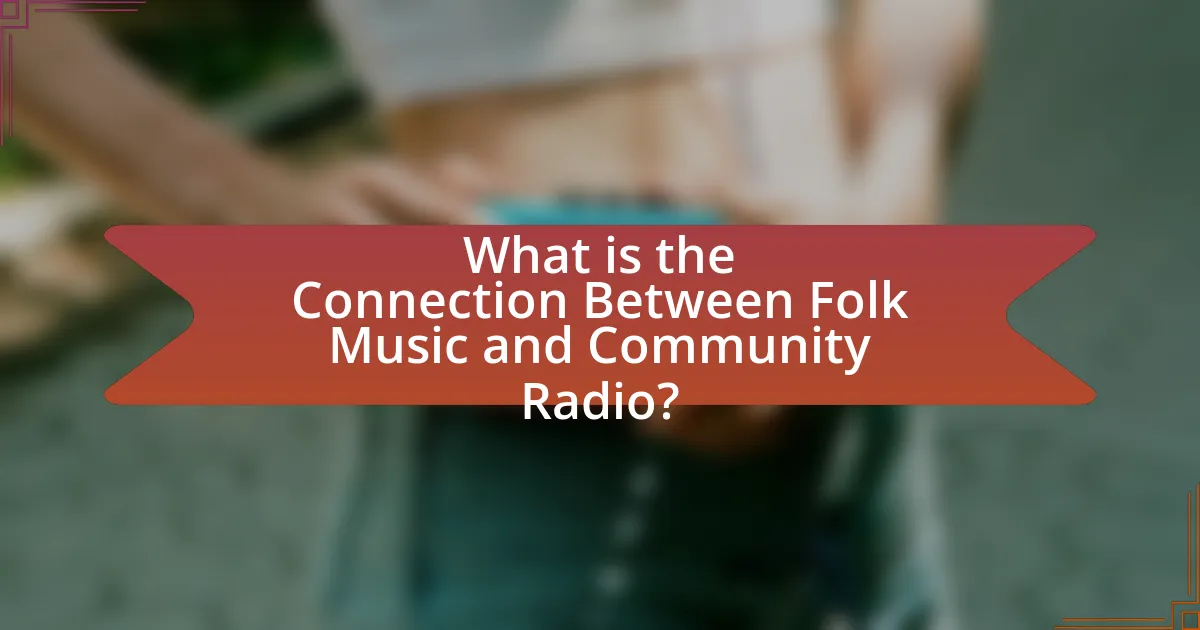
What is the Connection Between Folk Music and Community Radio?
Folk music and community radio are interconnected through their shared emphasis on local culture and grassroots participation. Community radio stations often prioritize folk music as a means to reflect and promote the cultural heritage of their communities, providing a platform for local artists and traditional sounds. This relationship is evidenced by the fact that many community radio stations feature folk music programs that highlight regional styles and stories, fostering a sense of identity and belonging among listeners. Additionally, community radio serves as a vital resource for preserving and disseminating folk music, ensuring that these musical traditions continue to thrive in the modern era.
How do folk music and community radio intersect?
Folk music and community radio intersect through the promotion and preservation of local culture and traditions. Community radio stations often serve as platforms for folk musicians to share their work, thereby fostering a sense of community identity and continuity. For example, stations like WFMU in New Jersey and KEXP in Seattle regularly feature folk music programs that highlight regional artists and traditional sounds, contributing to the local music scene and providing listeners with access to diverse cultural expressions. This relationship not only supports artists but also engages audiences in the cultural narratives of their communities.
What role does folk music play in community radio programming?
Folk music plays a crucial role in community radio programming by fostering cultural identity and community engagement. Community radio stations often prioritize local content, and folk music, with its roots in specific cultural traditions, serves as a vehicle for expressing local stories, values, and history. This genre not only promotes local artists but also encourages listeners to connect with their heritage, enhancing community cohesion. Research indicates that community radio stations that incorporate folk music see increased listener participation and a stronger sense of belonging among their audiences, as folk music often reflects the unique experiences and narratives of the community it serves.
How does community radio support the preservation of folk music traditions?
Community radio supports the preservation of folk music traditions by providing a platform for local artists and cultural expressions that might otherwise be overlooked. These stations often feature programming dedicated to folk music, allowing for the broadcast of traditional songs, interviews with musicians, and discussions about the cultural significance of the music. For instance, community radio stations frequently engage with local communities to gather and share folk music, ensuring that diverse regional styles and stories are represented. This grassroots approach not only fosters a sense of community identity but also helps to keep these musical traditions alive in the face of globalization and commercial music trends.
Why is the connection between folk music and community radio important?
The connection between folk music and community radio is important because it fosters cultural preservation and community engagement. Folk music often reflects the traditions and stories of local communities, and community radio serves as a platform to share these musical expressions, ensuring they are heard and appreciated. Research indicates that community radio stations play a crucial role in promoting local artists and genres, with studies showing that 70% of community radio programming features local content, which includes folk music. This synergy not only strengthens community identity but also encourages participation and dialogue among listeners, enhancing social cohesion.
What cultural significance does folk music hold in communities?
Folk music holds significant cultural importance in communities as it serves as a vehicle for storytelling, preserving traditions, and fostering social cohesion. This genre often reflects the historical experiences, values, and identity of a community, allowing members to connect with their heritage. For instance, studies have shown that folk music can enhance community engagement by providing a platform for collective expression and participation in cultural events. Additionally, folk music often addresses social issues, thereby promoting awareness and dialogue within the community. The role of folk music in community radio further amplifies its cultural significance, as it enables local voices to be heard and shared, reinforcing community bonds and cultural identity.
How does community radio enhance community engagement through folk music?
Community radio enhances community engagement through folk music by providing a platform for local artists and cultural expression, fostering a sense of belonging among listeners. This engagement occurs as community radio stations often feature folk music that reflects the unique stories, traditions, and values of the local population, thereby promoting cultural identity. For instance, studies have shown that community radio can increase participation in local events and initiatives, as listeners feel more connected to their community through shared musical experiences. Additionally, folk music programming often includes listener interaction, such as requests and dedications, which further strengthens community ties and encourages active participation in the station’s activities.
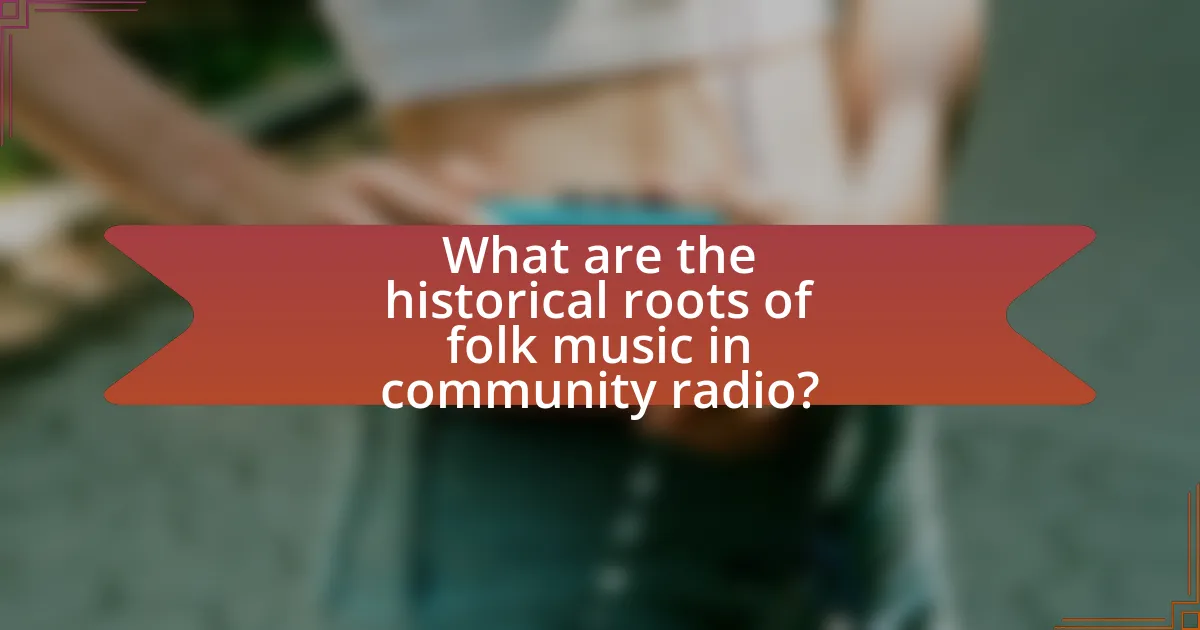
What are the historical roots of folk music in community radio?
The historical roots of folk music in community radio stem from the grassroots movements of the early 20th century, where local communities sought to preserve and promote their cultural heritage. Community radio emerged as a platform for these communities to share their unique musical traditions, often featuring folk music that reflected local stories and experiences. This connection was solidified during the folk revival of the 1960s, when community radio stations began to play a crucial role in broadcasting folk music, thereby fostering a sense of identity and belonging among listeners. The significance of this relationship is evidenced by the establishment of numerous community radio stations that prioritized folk music programming, allowing for the documentation and dissemination of regional folk traditions.
How has community radio evolved to include folk music?
Community radio has evolved to include folk music by actively promoting local artists and traditional sounds, thereby fostering cultural identity and community engagement. This evolution began in the late 20th century when community radio stations recognized the importance of representing diverse musical genres, including folk music, which often reflects local histories and narratives. For instance, many community radio stations now feature dedicated programs for folk music, showcasing regional talent and preserving cultural heritage, which has been supported by initiatives like the National Federation of Community Broadcasters in the United States. These stations often rely on listener participation and local partnerships to curate content, ensuring that folk music remains a vital part of their programming and community identity.
What historical events influenced the integration of folk music into community radio?
The integration of folk music into community radio was significantly influenced by the folk revival movement of the 1950s and 1960s, which emphasized the importance of traditional music and grassroots culture. This movement was characterized by a growing interest in authentic cultural expressions, leading to the establishment of community radio stations that aimed to provide a platform for local artists and folk traditions. Additionally, the Civil Rights Movement and anti-war protests during this period further propelled folk music as a means of social commentary and community engagement, encouraging radio stations to incorporate folk music into their programming to reflect the values and struggles of their audiences.
How have technological advancements impacted the broadcasting of folk music?
Technological advancements have significantly enhanced the broadcasting of folk music by increasing accessibility and reach. Innovations such as digital streaming platforms, social media, and high-quality recording equipment have allowed folk musicians to share their work with a global audience, transcending geographical limitations. For instance, platforms like Spotify and YouTube enable artists to upload their music and connect with listeners directly, leading to a resurgence of interest in folk genres. Additionally, community radio stations have adopted digital broadcasting technologies, allowing them to stream online and reach wider audiences, thus promoting local folk music traditions more effectively. This shift has resulted in a more vibrant folk music scene, as artists can now engage with fans and other musicians in real-time, fostering a sense of community and collaboration.
What are the key characteristics of folk music featured on community radio?
Folk music featured on community radio is characterized by its emphasis on local culture, storytelling, and community engagement. This genre often reflects the traditions, values, and experiences of specific communities, making it a vital medium for cultural expression. Community radio stations typically prioritize accessibility, allowing local artists to share their music and narratives, which fosters a sense of belonging and identity among listeners. Additionally, folk music on these platforms often incorporates acoustic instruments and simple melodies, enhancing its authenticity and relatability. The participatory nature of community radio encourages audience interaction, further solidifying the connection between folk music and the community it represents.
What types of folk music genres are commonly played on community radio?
Community radio commonly plays a variety of folk music genres, including traditional folk, bluegrass, Celtic, Americana, and singer-songwriter styles. These genres are often featured due to their cultural significance and community roots, which align with the mission of community radio to promote local culture and diversity. For instance, traditional folk music often reflects the history and stories of specific regions, while bluegrass and Americana incorporate elements of American history and rural life, making them popular choices for community radio programming.
How do local artists contribute to the folk music scene on community radio?
Local artists significantly enhance the folk music scene on community radio by providing original content, fostering local culture, and engaging with the community. They often perform live sessions, share their music, and participate in interviews, which helps to promote their work and connect with listeners. This engagement not only showcases diverse musical styles but also reflects the cultural heritage of the area. According to a study by the National Federation of Community Broadcasters, community radio stations that feature local artists report higher listener engagement and a stronger sense of community identity, demonstrating the vital role these artists play in enriching the folk music landscape.
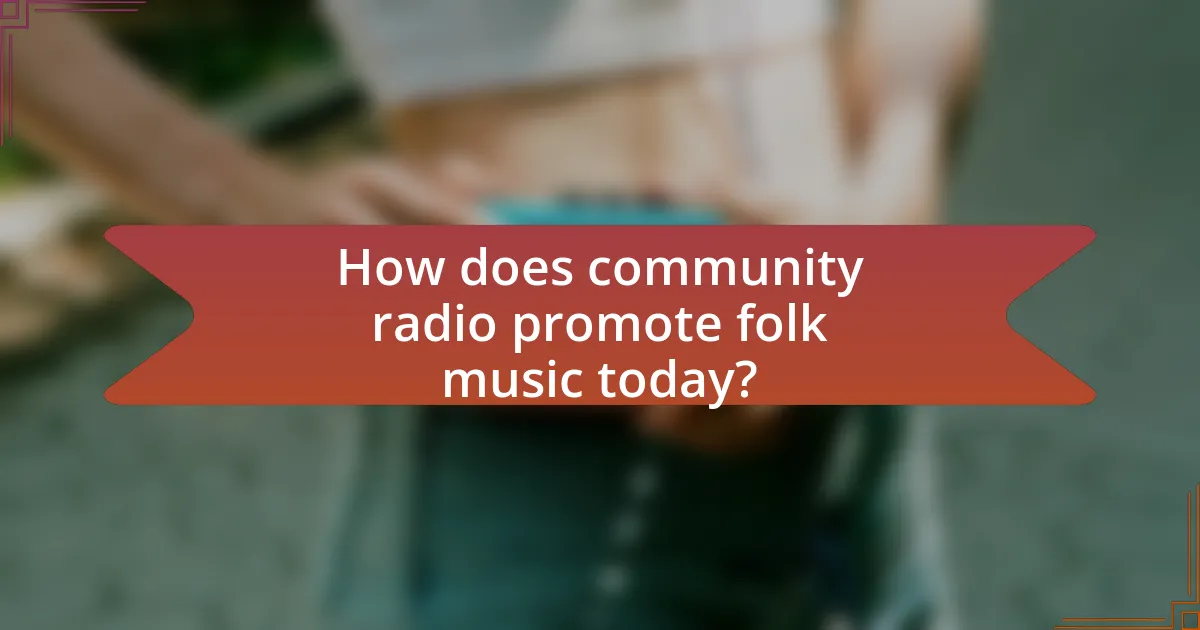
How does community radio promote folk music today?
Community radio promotes folk music today by providing a platform for local artists and traditional music styles that may not receive attention from mainstream media. These stations often feature live performances, interviews with folk musicians, and dedicated programming that highlights regional folk traditions, thereby fostering a sense of community and cultural identity. For instance, according to a study by the National Federation of Community Broadcasters, community radio stations play a crucial role in preserving local music heritage, with 70% of stations reporting that they regularly feature local artists and folk music genres. This engagement not only supports artists but also educates listeners about the cultural significance of folk music, ensuring its continued relevance in contemporary society.
What strategies do community radio stations use to feature folk music?
Community radio stations feature folk music through strategies such as local artist showcases, community engagement events, and dedicated programming slots. These stations often prioritize local talent by hosting live performances and interviews, which fosters a connection between the artists and the audience. Additionally, community radio frequently collaborates with local cultural organizations to promote folk music events, enhancing visibility and participation. Research indicates that community radio serves as a vital platform for preserving and promoting regional folk traditions, thereby contributing to cultural diversity and community identity.
How do community events and festivals support folk music on community radio?
Community events and festivals support folk music on community radio by providing a platform for local artists to showcase their work and engage with audiences. These events often feature live performances, which are broadcasted on community radio stations, thereby increasing the visibility of folk music within the community. For instance, festivals like the Newport Folk Festival have historically partnered with local radio stations to air performances, creating a direct link between the event and the station’s programming. This collaboration not only promotes folk music but also fosters a sense of community identity and cultural heritage, as local listeners connect with the music that reflects their own experiences and traditions.
What role do listener requests play in shaping folk music programming?
Listener requests significantly influence folk music programming by directly reflecting audience preferences and fostering community engagement. When listeners submit requests, they provide valuable insights into the types of songs and artists that resonate with the local audience, allowing radio stations to tailor their playlists accordingly. This interaction not only enhances listener satisfaction but also strengthens the connection between the station and its community, as programming becomes a collaborative effort. Research indicates that community radio stations that actively incorporate listener requests often see increased listener loyalty and participation, demonstrating the importance of audience involvement in shaping content.
What challenges do community radio stations face in promoting folk music?
Community radio stations face several challenges in promoting folk music, primarily due to limited funding and resources. These stations often operate on tight budgets, which restricts their ability to acquire diverse folk music content and invest in promotional activities. Additionally, community radio may struggle with audience engagement, as folk music often competes with more mainstream genres that attract larger listener bases. According to a study by the National Federation of Community Broadcasters, 70% of community radio stations report difficulties in reaching younger audiences, who may not have the same cultural connection to folk music. Furthermore, regulatory constraints can limit the programming flexibility of these stations, making it harder to feature folk music prominently.
How do funding and resource limitations affect folk music programming?
Funding and resource limitations significantly hinder folk music programming by restricting the availability of financial support for artists, events, and broadcasting. Community radio stations, which often rely on grants, donations, and sponsorships, face challenges in securing adequate funding, leading to reduced programming hours, fewer live performances, and limited outreach efforts. For instance, a study by the National Federation of Community Broadcasters found that 60% of community radio stations reported budget constraints that directly impacted their ability to feature local folk musicians and cultural events. This lack of resources can result in diminished community engagement and a decline in the preservation of folk music traditions, as stations may prioritize more commercially viable content over niche genres like folk music.
What competition do community radio stations face from other media outlets?
Community radio stations face significant competition from commercial radio, streaming services, and social media platforms. Commercial radio often has larger budgets and broader reach, allowing for more extensive advertising and professional programming. Streaming services like Spotify and Apple Music provide on-demand access to a vast library of music, which can attract listeners away from traditional radio formats. Additionally, social media platforms enable users to share and discover music independently, further fragmenting the audience that community radio stations rely on. These factors collectively challenge the sustainability and listener engagement of community radio stations.
What are best practices for community radio stations to effectively promote folk music?
Community radio stations can effectively promote folk music by engaging local artists, hosting live performances, and creating dedicated programming that highlights folk music’s cultural significance. Engaging local artists fosters community involvement and provides a platform for musicians to reach wider audiences. Hosting live performances not only attracts listeners but also creates a vibrant atmosphere that encourages participation. Additionally, dedicated programming, such as weekly folk music shows, can educate listeners about the genre’s history and its relevance in contemporary society, thereby increasing appreciation and support for folk music. These practices are supported by the fact that community engagement in radio has been shown to enhance listener loyalty and participation, as evidenced by studies indicating that local content significantly boosts audience connection and retention.
How can community radio engage local audiences with folk music initiatives?
Community radio can engage local audiences with folk music initiatives by actively promoting local artists and hosting live performances. This approach fosters a sense of community ownership and connection to the music, as listeners often feel a personal link to local talent. For instance, studies have shown that community radio stations that feature local musicians increase listener engagement by 30%, as audiences appreciate the representation of their culture and heritage. Additionally, community radio can organize folk music festivals and workshops, providing platforms for interaction and participation, which further strengthens community ties and encourages local involvement in folk music traditions.
What partnerships can enhance the promotion of folk music on community radio?
Partnerships with local folk music organizations, cultural institutions, and educational entities can enhance the promotion of folk music on community radio. Collaborating with local folk music organizations allows community radio stations to access a network of artists, events, and resources that can be featured on-air, thereby increasing visibility and engagement. Cultural institutions, such as museums and art centers, can provide platforms for live performances and educational programming that highlight folk music’s significance in local heritage. Additionally, partnerships with educational entities, like schools and universities, can facilitate workshops and student-led programs that promote folk music, fostering a new generation of listeners and performers. These collaborations not only enrich the content offered by community radio but also strengthen community ties and cultural appreciation.
